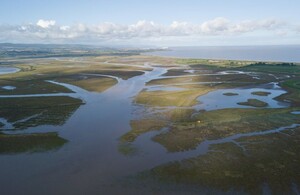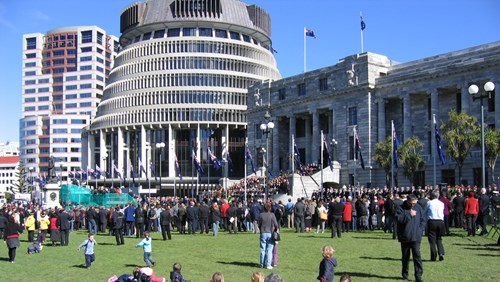
Wetlands And Coastal Protection
Wetlands can act as natural buffers to reduce wave energy.
Natural coastal protection and risk reduction by intertidal wetlands Iris Möller 1 and Tom Spencer 2
1 Department of Geography, Trinity College, Dublin, Ireland
2 Cambridge Coastal Research Unit, University of Cambridge, United Kingdom
Natural flood management (NFM) protects, restores or emulates the natural functions of rivers, floodplains, catchments and the coast to reduce flooding and coastal erosion. It can take the form of wetland restoration. Wetlands can be very beneficial for reducing flood risks while also providing wider environmental benefits.
Research from the Cambridge Coastal Research Unit (CCRU) demonstrated the critical role that coastal wetlands play as natural buffers against storm impacts. This work not only transformed understanding and attitudes toward coastal ecosystems, but has influenced policy and practice.
Impact
The findings from CCRU helped to shift the narrative on coastal management. The UK Climate Change Risk Assessment (CCRA2) highlighted flooding and coastal change as the highest climate risk for the UK, and identified an urgent need for effective, sustainable solutions. With rising sea levels projected to impact approximately 1,000km (20%) of England’s coastal defences by 2100, reliance solely on hard engineering is becoming increasingly untenable (Environment Agency, 2024).
The CCRU’s extensive research provided compelling evidence that coastal wetlands, such as salt marshes, significantly dissipated wave energy during storms, and by doing so helped to protect coastal communities and infrastructure. By acting as natural barriers, these ecosystems reduce the wave heights that reach man-made structures, either decreasing the need for hard engineering solutions or the cost of their construction and maintenance where they are needed.
The CCRU’s work was pivotal in advocating for the policy of ‘managed realignment.’ This strategy promotes restoring natural habitats by allowing the coastline to adjust in a way that benefits both the environment and human communities. By creating new habitat areas and reducing maintenance costs associated with artificial defences, managed realignment represents an approach to coastal management that aligns with both ecological and economic goals.
Through field campaigns and experimental research, the CCRU quantified the extent to which wave energy is mitigated by coastal wetlands. Studies conducted in Essex estuaries and Morecambe Bay found that salt marshes can reduce wave heights by 15-20% during extreme storms, enhancing the stability of adjacent infrastructure. This research considered various factors, including water depth, wave height, vegetation type, and sediment characteristics, providing a nuanced understanding of how these ecosystems offer coastal protection.
Experiments conducted in the world’s longest wave flume illustrated that even a 40 metre wide band of salt marsh can effectively lower storm wave heights, with a notable percentage of this reduction attributed to the plants and the stable sediment they create. This evidence was important for informing coastal management practices and illustrating the benefits of preserving and restoring natural habitats.
In 2017 the Environment Agency published the ‘ Working with natural processes evidence directory for flood and coastal risk management ‘ and it was updated in 2024 . These publications referenced field and laboratory work from this research which demonstrated that saltmarshes can reduce wave heights under extreme wave and water level conditions.
Principal Scientist, Flood & Coastal Risk Management Research, Environment Agency (2017) said:
This evidence [from the CCRU] has been very important in helping [the Environment Agency] develop and publish our Natural Flood Management evidence base…to mainstream more natural approaches to flood and coastal erosion risk management.
In addition to influencing policy, the CCRU has developed models and visualisation tools to help coastal managers understand and implement natural coastal protection strategies. By integrating scientific research with practical applications, these tools empower decision-makers to incorporate wetlands into coastal defence plans.
Head of People Conservation Science, RSPB (2020) said:
I can confidently say that research by the Cambridge Coastal Research Unit (CCRU) has provided the critical scientific underpinning for RSPB positions on natural coastal protection and coastal habitat restoration, allowing us to advocate for and secure improvements to government coastal management policies. This helps in advocacy of the benefits of our managed realignment coastal habitat work at sites such as Titchwell, Wallasea Island and Medmerry.
The work of the CCRU has thus emphasised the importance of viewing coastal wetlands not merely as natural environments but as essential components of flooding and erosion management strategies.
Resources
Christie, E.K., Spencer, T., Owen, D., McIvor, A.L., Möller, I., and Viavattene, C. (2018). Regional coastal flood risk assessment for a tidally dominant, natural coastal setting: North Norfolk, southern North Sea. Coastal Engineering, 134, 177-190. Available at: 10.1016/j.coastaleng.2017.05.003 (Accessed: 24 March 2025).
Environment Agency. (2024). National assessment of flood and coastal erosion risk in England 2024. Available at: National assessment of flood and coastal erosion risk in England 2024 (Accessed: 24 March 2025).
Kiesel J., Schuerch M., Christie E.K., Möller I., Spencer T., and Vafeidis A.T. (2020). Effective design of managed realignment schemes can reduce coastal flood risks. Estuarine, Coastal Shelf Science 242, 106844 Available at: doi: 10.1016/j.ecss.2020.106844 (Accessed 24 March 2025).
Möller I., and Spencer T. (2002). Wave dissipation over macro-tidal saltmarshes: Effects of marsh edge typology and vegetation change. Journal of Coastal Res., SI 36, 506-521. Available at: doi: 10.2112/1551-5036-36.sp1.506 (Accessed: 24 March 2025).
Möller, I. (2006). Quantifying saltmarsh vegetation and its effect on wave height dissipation: results from a UK East coast saltmarsh. Journal of Estuarine, Coastal, and Shelf Sciences, 69, 337-351. Available at: doi:10.1016/j.ecss.2006.05.003 (Accessed: 24 March 2025).
Möller I., Kudella M., Rupprecht F., Spencer T., Paul M., van Wesenbeeck B.K., Wolters G., Jensen K., Bouma T.J., Miranda-Lange M., and Schimmels S. (2014). Wave attenuation over coastal salt marshes under storm surge conditions. Nature Geoscience, 7, 727-731 Available at: doi: 10.1038/ngeo2251 https://www.nature.com/articles/ngeo2251 (Accessed: 24 March 2025).
Möller, I. (2018). The storm is over. Available at: Salt Marshes under Extreme Waves – An EU Hydralab+ project (Accessed: 24 March 2025).
Rupprecht, F., Möller I., Paul, M., Kudella, M., Spencer, T., van Wesenbeeck, B.K., Wolters, G., Jensen, K., Bouma, T.J., Miranda-Lange, M., and Schimmels, S. (2017). Vegetation-wave interactions in salt marshes under storm surge conditions. Ecological Engineering, 100, 301-315. Available at: doi: 10.1016/j.ecoleng.2016.12.030 (Accessed: 24 March 2025).
UNISDR Scientific and Technical Advisory Group Case Studies. (2014). Recognising
Natural Coastal Protection and Risk Reduction by Intertidal Wetlands. Available at: Prevention Web – Spencer Coastal Protection (Accessed: 24 March 2025).
Funder
1993 to 1996: PhD Studentship to IM: Natural Environment Research Council with Environment Agency (NERC Studentship No. GT4/93/7/P), UK, and Magdalene College Cambridge Scholarship.
2000 to 2004: Effect of salt marsh edge morphology and vegetation cover on wave attenuation EA R&D Project W5B-022.
2004 to 2005: Relationships between vegetation characteristics and sea defence value of saltmarshes RGS/EPSRC Geographical Research Grant
2011 to 2013: Wave dissipation and transformation over coastal vegetation under extreme hydrodynamic loading (EU HYDRALAB IV, flume project with Universities of Hamburg and Hannover (Germany), NIOZ and Deltares (NL)). EU FP7 Integrating Activity HYDRALAB IV, Contract No. 261529
2013 to 2014: Coastal ecosystems as a form of coastal defence, Newton Trust, Cambridge.
2014 to 2018: Foreshore Assessment using Space Technology (FAST) EU 7th Framework Prog. SP1-Cooper., FP7-SPACE-2013-1 (collaborator), Grant no. 607131, (£451K)
2018: Hydralab+ RESIST: EU Horizon 2020 research and innovation program (654110, HYDRALAB+).
2016 to 2020: Physical and biological dynamic coastal processes and their role in coastal recovery (BLUE-coast); NERC (Directed Research Programme; Grant NE/N015878/1) (collaboration with 9 other organisations)
2016 to 2020: Valuing the contribution which COASTal habitats make to human health and WEllBeing, with a focus on the alleviation of natural hazards (CoastWEB) NERC (Directed Research Programme; Grant NE/N013573/1 (collaboration with 7 other organisations)
2018 to 2021: Response of Ecologically-mediated Shallow Intertidal Shores and their Transitions to extreme hydrodynamic forcing in UK settings (RESIST-UK), NERC Standard Research Grant (collaborators: British Geological Survey, Queen Mary University London) Grant no: NE/R01082X/1
2023 to 2028: REWilding and Restoration of InterTidal sediment Ecosystems for carbon sequestration, climate adaptation and biodiversity support (REWRITE). Lead: Nantes University. EU HORIZON-CL5-2022-D1-02 funding call.
2023 to 2028: Nature-based solutions for climate-resilient, nature-positive, and socially just communities in diverse landscapes (NATURESCAPES). Lead: Utrecht University. EU HORIZON-CL6-2022-COMMUNITIES-01.
Research period
- 2000 – ongoing
Impact period
- 2013 – ongoing
Impact country
-
UK
-
USA
-
Europe
Contributing to the areas of research interest
- 5 – Asset management
https://www.gov.uk/government/case-studies/wetlands-and-coastal-protection


